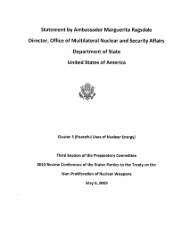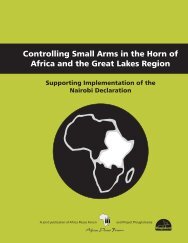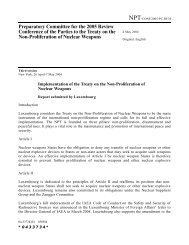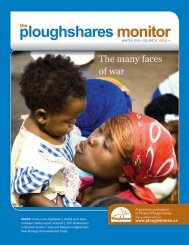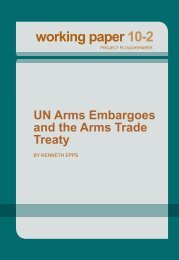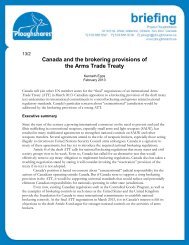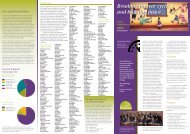Addressing Armed Violence in East Africa.pdf - Project Ploughshares
Addressing Armed Violence in East Africa.pdf - Project Ploughshares
Addressing Armed Violence in East Africa.pdf - Project Ploughshares
Create successful ePaper yourself
Turn your PDF publications into a flip-book with our unique Google optimized e-Paper software.
<strong>Address<strong>in</strong>g</strong> <strong>Armed</strong> <strong>Violence</strong> <strong>in</strong> <strong>East</strong> <strong>Africa</strong>3. KenyaThe role of women <strong>in</strong> perpetuat<strong>in</strong>g violence is mostly <strong>in</strong>direct.While women don’t take up arms, we were told that if thefamily has acquired a weapon it’s the duty of the mother to“bra<strong>in</strong>wash” youngsters about the f<strong>in</strong>ancial problems of thefamily, the cost and trouble to acquire the weapon, and how itmust be used. This apparently works to conv<strong>in</strong>ce the youth.Women can also be key to mak<strong>in</strong>g peacewith<strong>in</strong> and between communities.Male and female identities are closely allied with traditionalgender roles with<strong>in</strong> pastoralist societies. One person<strong>in</strong>terviewed said: “Those raiders who are brave, their braveryis known. When they return successfully, they command theattention of young ladies. There are songs <strong>in</strong> their honour andthe young ladies fall for them.” Another <strong>in</strong>dicated there are“some lady laibons, who are very tough, very powerful. Butma<strong>in</strong>ly it is the men who use the guns.”Women can also be key to mak<strong>in</strong>g peace with<strong>in</strong> and betweencommunities. In one small urban community they havewomen’s groups to make peace <strong>in</strong> the community. The mothersthere have sons <strong>in</strong> the rural areas, many of whom participate<strong>in</strong> raids, so these mothers get together and discuss how to helptheir sons. The mothers then go and talk to their own sons toconv<strong>in</strong>ce them not to get <strong>in</strong>volved <strong>in</strong> raids.Instruments of violenceIdentify<strong>in</strong>g the <strong>in</strong>struments of violence and their sources isan important part of assess<strong>in</strong>g how armed violence can bereduced or better controlled. As already noted from <strong>in</strong>terviews,the widespread <strong>in</strong>troduction of automatic weapons <strong>in</strong>to thesepastoralist areas fundamentally changed the nature andlethality of cattle raids.People were asked where these guns come from and how muchthe guns and ammunition cost.Interviewees identified guns as the most prom<strong>in</strong>ent weaponsused <strong>in</strong> armed violence <strong>in</strong> Turkana, Pokot and Marakwetcommunities. Guns were considered pervasive among theTurkana and Pokot, and the research team observed whiledriv<strong>in</strong>g <strong>in</strong> the rural areas that herders of goats and cattle, someappear<strong>in</strong>g to be young teenagers, carried guns.The most prevalent guns <strong>in</strong> the area were reportedly variationsof the AK-47, <strong>in</strong>clud<strong>in</strong>g the Ch<strong>in</strong>ese AK-47, which is<strong>in</strong>creas<strong>in</strong>gly available. The G3, M16 and Mark 4 guns were alsomentioned. The amakada and achegere guns were mentioned butnot def<strong>in</strong>ed. Pistols can be found <strong>in</strong> urban areas.“Bombs” – likely grenades –are also used to kill raiders and takelivestock. Rocket-propelled grenades (RPGs) were reportedlyused by the Sudanese. One <strong>in</strong>terviewee referred to a “big gunthat stands on its own and can throw a ‘bomb’”.Also mentioned were less common but more traditional weaponssuch as spears, small arrows, poisoned arrows, sticks and spears.Most commonly used <strong>in</strong> post-election violence were machetes,and match sticks and petrol for torch<strong>in</strong>g houses. Another tacticnamed was to poison dr<strong>in</strong>k<strong>in</strong>g water, such as the pool beh<strong>in</strong>d adam, affect<strong>in</strong>g people and livestock. As well, enemies reportedlysold sick goats to spread disease through the herds of theiropponents.The market for gunsIn Kenya it was relatively straightforward to get answers toquestions <strong>in</strong> <strong>in</strong>terviews about the cost of guns and ammunition.The cost of an AK-47 was frequently cited as eight cows or about50,000 Kenyan shill<strong>in</strong>gs (KSh) or US$625, although the qualityand therefore the value of cows can vary. One <strong>in</strong>tervieweeput the cost of an AK-47 much lower at KSh15,000–20,000(US$187.50–250). In one <strong>in</strong>terview an AK-47 was said to cost12–15 cows, and a better value if paid <strong>in</strong> cows than <strong>in</strong> cash.Another said an AK-47 cost 80 cows when guns were <strong>in</strong>troduced<strong>in</strong> the early 1970s, but now cost seven or eight cows. Mostclaimed that bullets for an AK-47 cost KSh100 (US$1.25) each,while a few reported a cost of KSh150 (US$1.88). Bullets costKSh10 (US 12 cents) <strong>in</strong> the 1990s. An RPG reportedly costKSh70,000 (US$875), an amakada KSh30,000 (US$375) and anachegere KSh40,000 (US$500).The Turkana <strong>in</strong>terviews gave the strong impression that thePokot have more guns than Turkana or Marakwet. One person<strong>in</strong>terviewed disagreed. The Pokot live along a border supply areawith Uganda where the Karamojong readily traffic <strong>in</strong> weapons.Pokot crim<strong>in</strong>als were <strong>in</strong>dicated as the source of guns by bothTurkana and Marakwet. Sometimes the Pokot were reportedto lend guns to crim<strong>in</strong>als, who then bought guns with moneystolen <strong>in</strong> their robberies. Turkana also reportedly bought gunsfrom Pokot. These weapons were obta<strong>in</strong>ed, accord<strong>in</strong>g to people22



